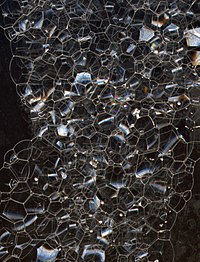
Photo from wikipedia
Resorcinol/formaldehyde (RF) foam-aluminum-quartz-layered targets were shock compressed up to 0.9 TPa in quartz to quantitatively evaluate the pressure-amplification effect of using a low-density RF foam as an ablator. The velocimetry… Click to show full abstract
Resorcinol/formaldehyde (RF) foam-aluminum-quartz-layered targets were shock compressed up to 0.9 TPa in quartz to quantitatively evaluate the pressure-amplification effect of using a low-density RF foam as an ablator. The velocimetry and pyrometry were used to obtain the shock pressure and temperature in the quartz. The results show the use of an RF foam ablator with a density of 100 mg/cm3 increases the peak pressure of quartz by 76 (±11)% compared to the case with a polypropylene ablator. Our results also confirm that preheating of the quartz ahead of the shock wave due to the x rays produced in the ablated foam is negligible, indicating that a low-density RF foam is an ideal ablator material for laser-shock experiments.
Journal Title: Physics of Plasmas
Year Published: 2021
Link to full text (if available)
Share on Social Media: Sign Up to like & get
recommendations!